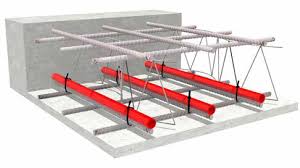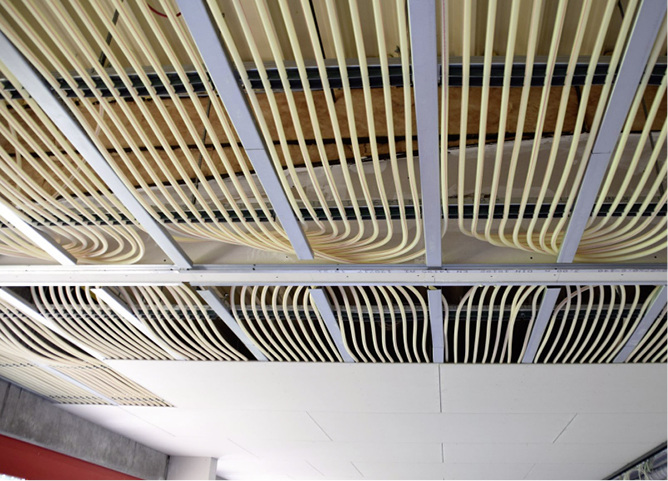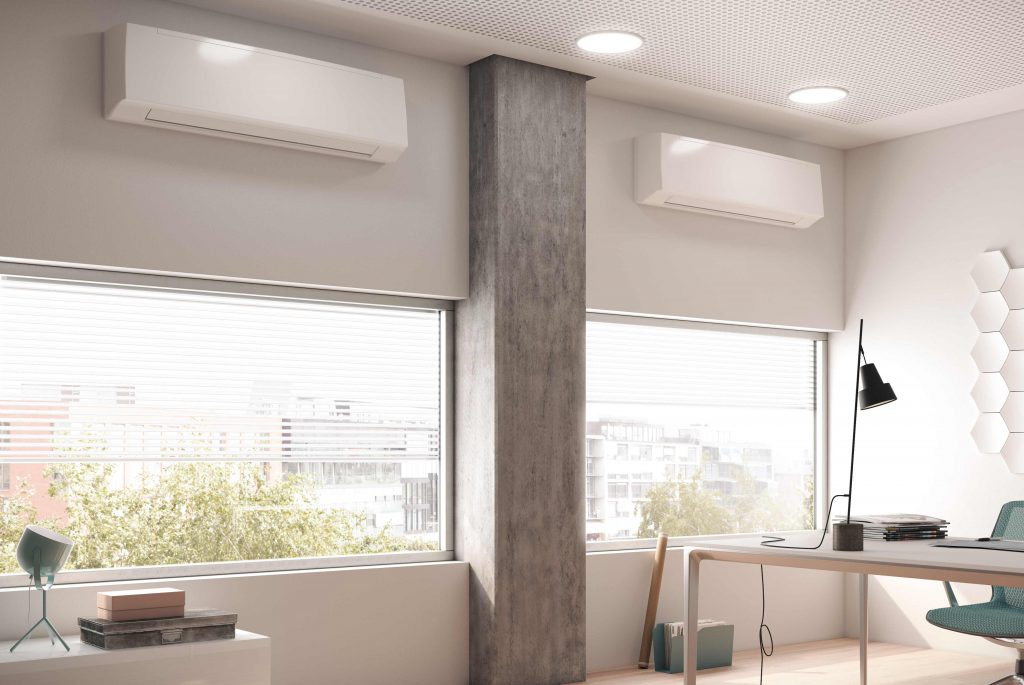Cooling delivery systems
For absorption and adsorption systems, the following cold delivery systems can be considered:
Building component activation
Chilled ceilings
Floor cooling
Fan convectionFor the DEC, however, fan convection or cooling ceilings are primarily suitable.
Building component activation

Building component activation enables the dissipation and supply of heat via load-bearing components of a building. This requires well thought-out planning and control and makes it possible to use large storage masses and areas without having to carry out additional installations (radiators, fans, etc.) in the rooms. This allows for a free interior design and comfortable, because hardly noticeable, but effective cooling. The disadvantages are the great inertia of the masses and lack of flexibility after the system is completed. Cooling capacities of 40 watts per m2 active surface can be achieved, which may be too little in the case of rapidly occurring load peaks.
Component activation can be carried out using water or air as the heat transfer medium. Air ducts must be dimensioned much larger than water pipes for the same performance and lead to a significant weakening of the component. However, this may be desirable under certain circumstances in order to optimise ceiling weights, for example. (Source: Austrian Research and Testing Centre Arsenal Ges.m.b.H., 2007)
Cooling ceiling

Cooling ceilings, like the activation of building components, offer comfortable cooling in the form of radiation over a large area. They are retrofitted to the ceiling and may require a false ceiling. They can influence the interior design, but can also be retrofitted and are more flexible than component activation. From a control point of view, chilled ceilings are unproblematic, as there are no large storage masses. (Source: Austrian Research and Testing Centre Arsenal Ges.m.b.H., 2007)
Induction system

Induction units blow fresh air into the room in such a way that the room air and supply air mix immediately for the most part. By regulating the supply air accordingly, the room air can be cooled or heated and the humidity can be adjusted. The cooling or heating can be done room-specifically via a water network or via a central air conditioning unit. In the case of large cooling capacities, draughts can occur due to the tangential flow rollers. The installation can be carried out subsequently, but requires a large amount of space and has only limited flexibility. Achievable outputs are between 40 and 80 watts per m2 of office space.
Induction units can be installed on the ceiling, floor or parapet, depending on the room use and geometry. (Source: Austrian Research and Testing Centre Arsenal Ges.m.b.H., 2007)
Fan coils

When cooling with fan coils, usually no fresh air is supplied to the room, but the room air is sucked in at one point, cooled or heated by fan coils and returned to the room. This enables cooling and simultaneous dehumidification as well as heating. If no fresh air is supplied, the installation effort for the pipe routing is reduced. This system responds very quickly to load changes and can work individually for each room. However, the fan coils are maintenance-intensive, require air exchange via window ventilation and can cause drafts. The boxes with the fan coils can be installed on the ceiling, floor or parapet. Achievable outputs are between 40 and 80 watts per m2 of office space. (Source: Austrian Research and Testing Centre Arsenal Ges.m.b.H., 2007)

 Disclaimer: Powered by Erasmus+, ACTeco, ASBN and d.sign Gruber & Partner
Disclaimer: Powered by Erasmus+, ACTeco, ASBN and d.sign Gruber & Partner
You must be logged in to post a comment.